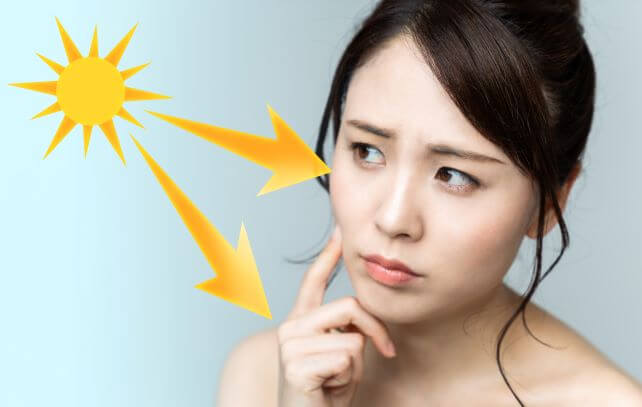You’re probably aware that exposure to the sun’s ultraviolet (UV) light isn’t great for your skin. You may even know that there are two main kinds of UV rays in sunlight – UVA and UVB, but not everyone knows that UVA and UVB rays impact the skin differently. According to Dr. Mahsa Karavan, “UVA and UVB rays will both damage skin, but UVB rays are more closely related to short-term skin damage, and UVA is more likely to lead to long-term damage. Because both types of UV rays can damage our skin, it’s essential to find sunscreens and other skin protection products that keep skin safe from both UVA and UVB rays.” In this blog, Dr. Karavan explains the difference between UVA and UVB rays and how to prevent damage from all types of UV rays.
What Are Ultraviolet Rays?
Ultraviolet rays, also called UV radiation or UV rays, are natural forms of lightwave energy produced by the sun. The sun’s light energy keeps the earth warm, helps plants to grow, and provides other necessary functions that are essential to healthy life on earth. Reading this, you may think that means that UV rays are the source of the golden sunlight we enjoy on sunny days. Actually, UV radiation waves are not visible. According to Dr. Karavan, “Most people think they would know if the sun was impacting them because it would be bright and sunny outside. However, UV rays can harm skin when it’s cloudy outside or even when it’s raining. You don’t need to see bright sunlight for UV rays to impact the skin.” In addition to sunlight, UV rays are also found in tanning beds, grow lights, black lights, and other light sources.
What’s the Difference Between UVA & UVB Rays?
Both types of ultraviolet rays can damage the skin. The difference is in how they cause damage. After exposure to either UVA or UVB rays, the body seeks to protect itself by adding pigment to the skin. This leads to suntans and sunburns. UVA rays are more likely to lead to tanning rather than burning, but both sunburns and suntans are your body’s way of defending against UV damage. UVA rays are longer wavelengths, and exposure to UVA rays is linked with tanned skin in the short-term and accelerated signs of skin aging like wrinkles, fine lines, and dark spots in the long term. UVB rays are shorter wavelengths. These shorter UV rays are connected with sunburns and other immediate forms of skin damage.
While UVA and UVB rays may impact the skin in different ways, direct exposure to either form of UV radiation has the potential to damage skin on the cellular level. Repeated or prolonged exposure to UV rays significantly increases the chances of developing all forms of skin cancer, including basal cell carcinoma and squamous cell carcinoma. These two common forms of skin cancer typically respond well to treatment and are rarely the cause of skin cancer-related deaths unless they are left untreated. Melanoma skin cancer is also a serious risk associated with exposure to both UVA and UVB rays, especially if a person develops a sunburn. While it’s not as common as the other two forms of skin cancer, Melanoma has the highest risk of metastasization (spreading to other parts of the body), which can lead to death, so it’s important to receive treatment for melanoma as quickly as possible. Even though it is less aggressive in nature, squamous cell carcinoma also causes significant mortality every year due to its potential for metastasis. Therefore it is important to detect both melanoma and squamous cell carcinoma at the earliest stage.
Additionally, both types of UV rays have been linked to serious conditions related to vision, including ocular melanoma and cataracts. UV radiation can be used by medical professionals, including dermatologists, to treat a variety of conditions, but even this controlled exposure poses a risk. It’s important to seek out other forms of treatment first and only rely on treatments that use ultraviolet light when other, more conservative solutions are ineffective.
How Do UVA Rays Impact Skin Health?
UVA rays are the shortest and most prevalent of the sun’s rays, but they have the least energy. About 95% of the UV rays that reach the earth are UVA, and while they are weaker than UVB rays, they maintain the same strength throughout the day and all year long. UVA rays can even penetrate through windows, clouds, and other forms of shade, which means humans are exposed to a large amount of UVA radiation. With prolonged exposure, UVA rays can contribute to sunburns and suntans, but they are more commonly the cause of long-term skin damage like fine lines, wrinkles, and age spots. They can also damage the skin’s cellular DNA, increasing the risk for skin cancers. According to Dr. Karavan, “In the past, sunscreens only protected from UVB rays because UVA was less likely to cause immediate damage like sunburns. UVA rays were also what most tanning beds used since they were considered the safer form of UV radiation. Now that we understand the long-term impact of exposure to UVA rays, dermatologists know how important it is to minimize exposure to both forms of UV radiation. The first step people should take to protect their skin from UVA rays is to find a sunblock that offers broad-spectrum protection.”
Dr. Karavan went on to describe the reason UVA rays may pose a more serious risk for skin cancer saying, “UVA rays don’t have as much of an immediate impact on the skin because they penetrate deeper below the skin’s surface. They aren’t damaging the layers of skin you see right away. Instead, they damage the new, developing skin cells below the surface. This is where the majority of skin cancers develop, making UVA radiation a significant contributor to skin cancer risk.”
How Do UVB Rays Impact Skin Health?
When it comes to UVB rays, Dr. Karavan says, “There is no such thing as safe UV exposure, but while UVA rays are a significant contributor to long-term skin damage and skin cancers, UVB rays are responsible for immediate damage to the skin like sunburns and may be more likely to cause skin cancers, especially melanoma.” Like exposing skin to other sources of heat, exposure to the longer, higher energy UVB rays is more likely to burn the skin. It is the main cause of sunburns, especially severe and blistering sunburns. Unlike UVA rays, UVB damage doesn’t typically penetrate beneath the outer layers of skin, which is why UVB damage is the most immediate. However, it can still contribute to cellular damage that leads to the development of skin cancer. Unlike UVA rays that have steady, lower energy, UVB rays are stronger from mid-morning to mid-afternoon, and these rays are more intense in the spring, summer, and fall and weaker in the winter. However, UVB rays can damage skin at any time of the year, especially in higher altitudes or areas where snow cover causes the light to reflect against the skin. UVB rays are not able to penetrate windows or other types of glass, and they do not penetrate cloud cover as easily as UVA rays.
How Can I Prevent UV Skin Damage?
According to Dr. Karavan, “It’s extremely important to protect skin from the damage of UVA and UVB rays, but that doesn’t mean you have to miss out on spending time enjoying the outdoors. It just means you need to be proactive and take steps to protect your skin from sun damage. The most important preventive measure you can take is to apply sunscreen every day, even when it’s cloudy or cold outside or you’re not going to be spending much time outdoors. The negative effects of UVA and UVB rays are cumulative, so even a little bit of exposure each day can add up over time.”
Keep the following tips in mind to protect skin from the sun’s damaging UVA and UVB rays:
- Choose a sunblock with a sun protection factor (SPF) of 30 or higher. The higher the SPF, the longer it takes for UVB to cause damage.
- Look for broad-spectrum sunscreens that protect from both UVA and UVB rays. If a sunscreen isn’t listed as broad-spectrum, it may only protect against UVB rays. Sun exposure, even to just UVA rays, can significantly increase the risk for long-term skin health concerns, including skin cancers.
- Make sure to follow sunscreen application instructions, including applying an adequate amount of sunblock, reapplying as necessary, and waiting after application before sun exposure. Most adults need approximately 1 ounce (volume of a full shot glass) to cover the exposed parts of their body.
- Minimize time outdoors during peak sun exposure hours between 10 am and 4 pm. This is the time of the day that UVB rays are strongest.
- Seek shade under umbrellas and trees or by going indoors periodically to allow the skin to rest and reduce the risk of sun damage.
- Wear light layers with long sleeves and pants to protect your skin.
- Wear wide-brim hats, gloves, sunglasses, and other protective accessories to keep skin and eyes safe from the sun’s damaging UV rays.
What Should I Do if I Notice Sun Damage?
After sun damage, Dr. Karavan recommends, “If you have a sunburn or even a suntan, make sure to keep your skin hydrated with aloe or other soothing moisturizing lotion or cream. This will relieve any discomfort associated with sunburns, and it will help promote healing and restore the skin’s protective barriers. Even one sunburn will increase your risk for skin cancer. If your skin has been burned or tanned regularly, it is absolutely essential to perform skin cancer self-exams once a month and visit a dermatologist every year for a professional screening.” If sunburns are severe, you may want to schedule an appointment with your dermatologist. For sunburns that blister, it’s important to seek appropriate care since these sunburns pose a greater risk for infection, scarring, and other long-term skin health concerns.
Visit U.S. Dermatology Partner to Learn More
Whether you’re dealing with the repercussion of UVA and UVB damage or you want to create the ideal skincare routine to protect skin from sun damage, the knowledgeable dermatologists at U.S., Dermatology Partners are here to help. When you’re ready to get started working with one of our local dermatology practice teams, simply take a few moments to fill out our online scheduling request form. A team member will be in touch soon to answer your questions and finalize the details of your upcoming visit.
Find a location near me
or


